

Home
About Us
Allotments
Garden Equipment
Seed Suppliers
Manure Problems
Children's Pages
GLA Blog
Weather Blog
School Veg Patch
Useful Links
Feeding the Birds#
Our garden has always been a place to share with wildlife. Being either nocturnal or too small to be able to observe without making an effort, lots of our wildlife visitors will go more or less unnoticed for much of the time leaving only traces of their presence. Birds, however, will readily adopt a garden as a favourite service station if they are provided with the essentials – food, water and places to nest and shelter.
Although we enjoy watching our feathered visitors throughout the year, it is during winter that birds provide the main focus of interest in our garden. They are our flying flowers. To encourage a wide range of birds to visit your garden you need to provide a variety of food and ways of offering it.
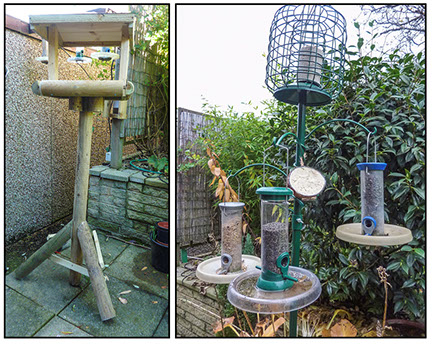 After years of active service one bird table in our garden has just about fallen apart, so we decided to buy a new one. Easier said than done, we browsed garden centres, pet shops and the Internet and just couldn’t find one to suit our requirements. The tables we saw didn’t have much surface area, they were too short or the roof was too low. The only answer was a do it yourself job and so Martyn set to and made one to our specifications.
After years of active service one bird table in our garden has just about fallen apart, so we decided to buy a new one. Easier said than done, we browsed garden centres, pet shops and the Internet and just couldn’t find one to suit our requirements. The tables we saw didn’t have much surface area, they were too short or the roof was too low. The only answer was a do it yourself job and so Martyn set to and made one to our specifications.
After a visit to a local RSPB reserve at Fairburn Ings we also decided to invest in a bird feeding station with a free-standing base so once we had the ‘equipment’ we needed to stock up on supplies of food.
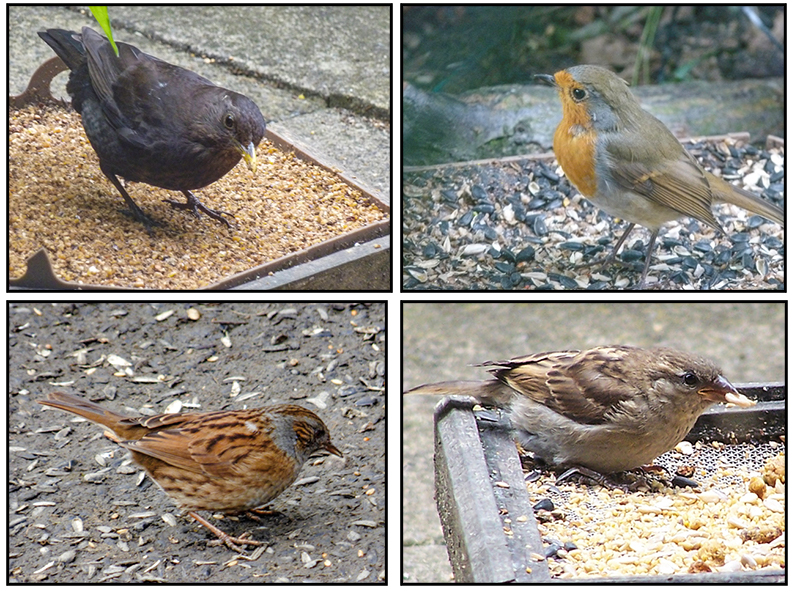
Different species of birds - or even some individuals - have different preferences with regards not only to the types of food that they prefer but also as to how they prefer to feed. Some prefer flat surfaces as their claws are not really adapted for clinging. Although some birds not 'designed' for clinging seem to have developed a technique that allows them to cling on to feeders. Some birds just feel safer off the ground.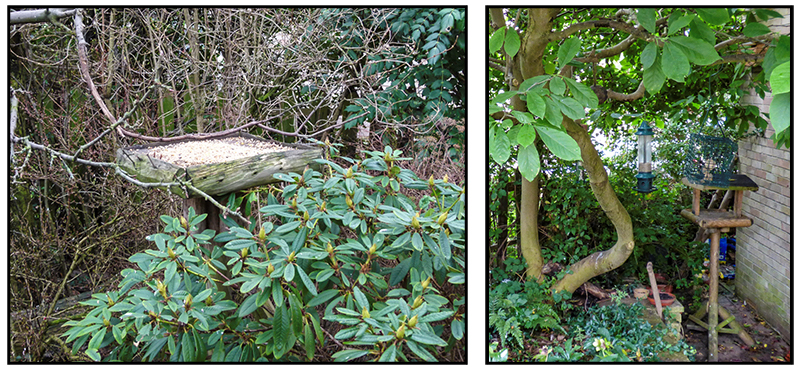
Some of our bird tables are set amongst shrubs and trees in which the birds can often be seen queuing to take their turn at feeding. The birds also feel safer here as they can quickly hide in the bushes or trees if danger threatens
Our bird tables not only provide a place to eat but are also often used as a place to shelter especially when it is pouring with rain.
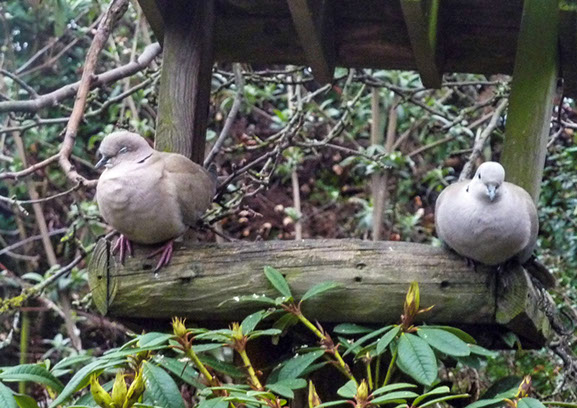
The two collared doves in the top photo amused us as they took turns to close their eyes.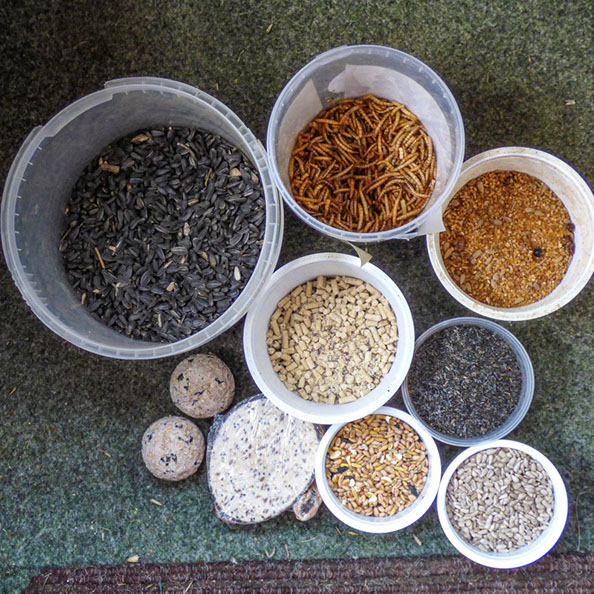
We pop a mixture of all the different types of food on our bird tables.
Advice on choosing and siting a bird table can be found here.
We also have a low ground feeding table which some birds like. The members of the thrush family tend to prefer this set-up and will approach on foot or claw rather than flying in.
The thrush family are insect and fruit eaters and so we buy special mixtures for them rather than just putting out seed.
These birds also love mealworms which we buy dried as we are too squeamish to provide them live!
We will also pop out any bruised fruit. As we grow our own apples there is no shortage.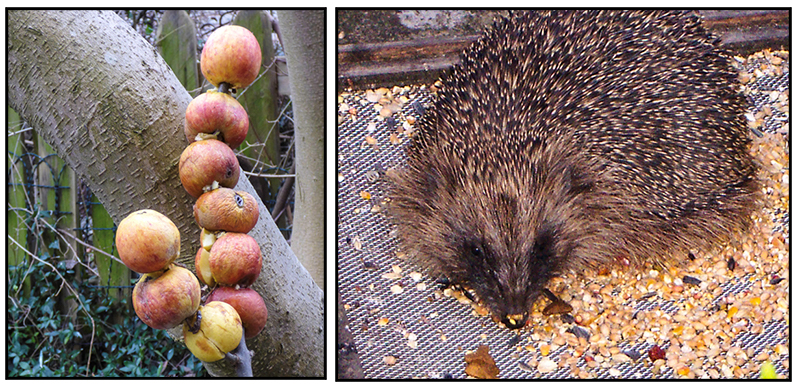
During summer the hedgehogs also like to visit and finish any food left behind by the birds.
Click here for more about hedgehogs
Other birds especially those belonging to the finch family will readily visit hanging feeders containing seed mixtures. Their beaks are strong enough to crack open seeds to get to the kernels inside it. Their claws are also adapted for clinging. Cages can be used to prevent larger birds and squirrels from raiding the feeders. Trays can also be fitted to the base of the feeders. These will catch some of the seed thrown about when the birds are feeding and also provide a platform to allow birds with claws not adapted for clinging such as the dunnock and robin.
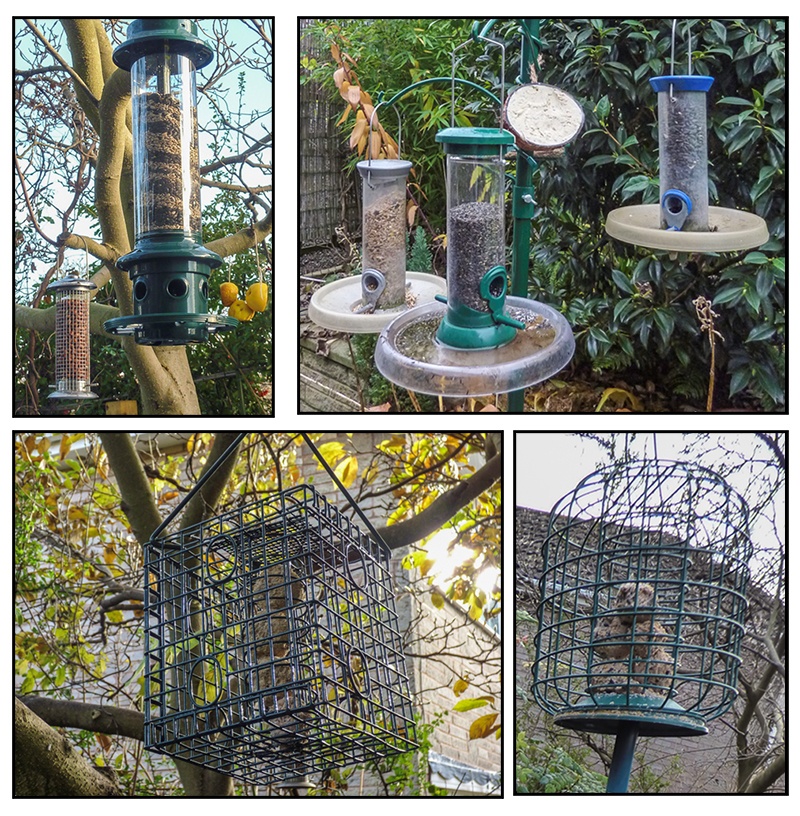
Many birds love black sunflower seeds. They are really rich in oils which help provide the birds with energy during winter and the breeding season. Black sunflowers seeds have softer shells than the larger striped seeds which smaller birds such as the coal tit on the bottom left find easier to split open. Birds from the tit family will fly to a perch with a sunflower seed in their beaks. There they will hammer like miniature woodpeckers to open the seed coating and gain access to the oil rich kernel.
All our garden birds seem to adore sunflower hearts. As these are more expensive we try to limit the number of birds that can access them at any given time.
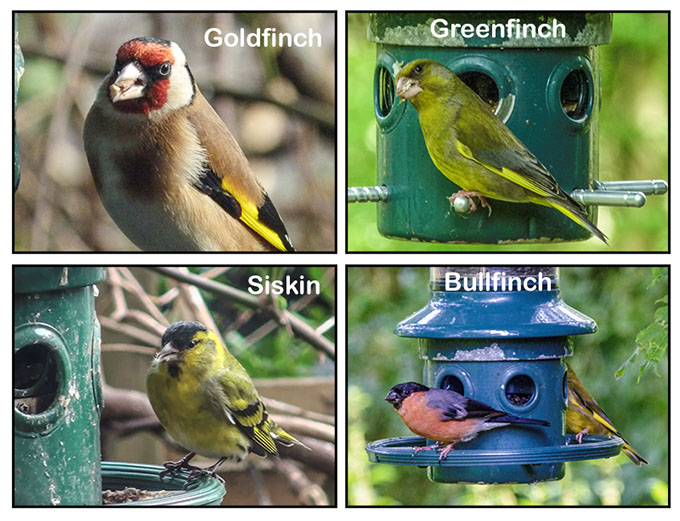
We do this by using a sort of spring loaded feeder which can be set so that if the weight on the perching ring exceeds a certain weight the feeder holes close. We have this set to a limit of the weight of two sparrows.
The squirrel will also raid this feeder given the chance and will hang from the branch on which the feeder is suspended in order to bypass our weight restriction.
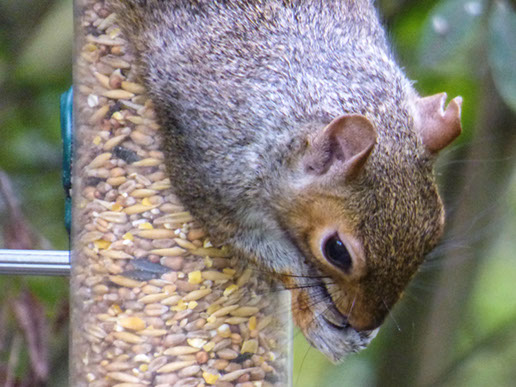
We have offset this by hanging the feeder from a long hook so that the squirrel can’t reach the food .
The squirrel is allowed access to other feeders. However, with their strong gnawing teeth squirrels will make very short work of plastic feeders.
Even the metal ones are vulnerable and so where squirrels are a problem nut feeders can be protected by cages.
So far we haven’t had to resort to using such methods of protection and the squirrels are welcome to visit as long as they behave.
It can be amusing to watch them collecting peanuts and diligently burying them in various places all over the garden. Our bird tables not only for birds.
We also have a feeder containing niger seed that is well visited by goldfinches - even the youngsters find their way to this food quickly. We have even had siskins feeding from this feeder. Originally we tried using a feeder specially designed for niger seed but found that the birds preferred the usual type of feeder.

Other hanging feeders contain peanuts. Peanuts can be bought in net bags but these may be dangerous to visiting birds as their claws can become entangled. The wire basket type of feeders in these photographs are much safer.
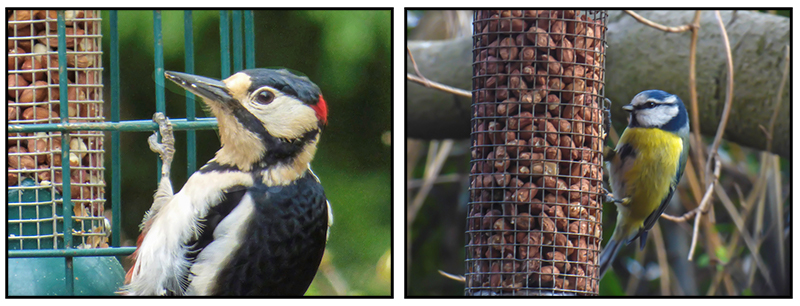
Birds will stay at peanut feeders for a while pecking through the wire to access bits of the nuts. The birds, especially tits, usually carry out a smash and grab raid of any nuts on the bird table taking the grabbed nuts into bushes to eat under cover.
The video below was filmed at an RSPB reserve and features a tree sparrow. Unfortunately we don't gave these visiting our garden.
We also fill peanut feeders with suet nibbles which the birds flock to.
There are lots of ways that you can provide energy giving fat treats to birds. Most are based on suet fat mixed with various other bird treats such as insects, mealworms, seed or fruit. Some fat balls are sold in net bags which should be removed to avoid the chance of birds trapping their claws in the mesh.
You can also make your own fat treats click here for more information about how we make ours. Although fat treats can be provided all year round they tend to melt and be messy in warmer weather – when we actually have any!
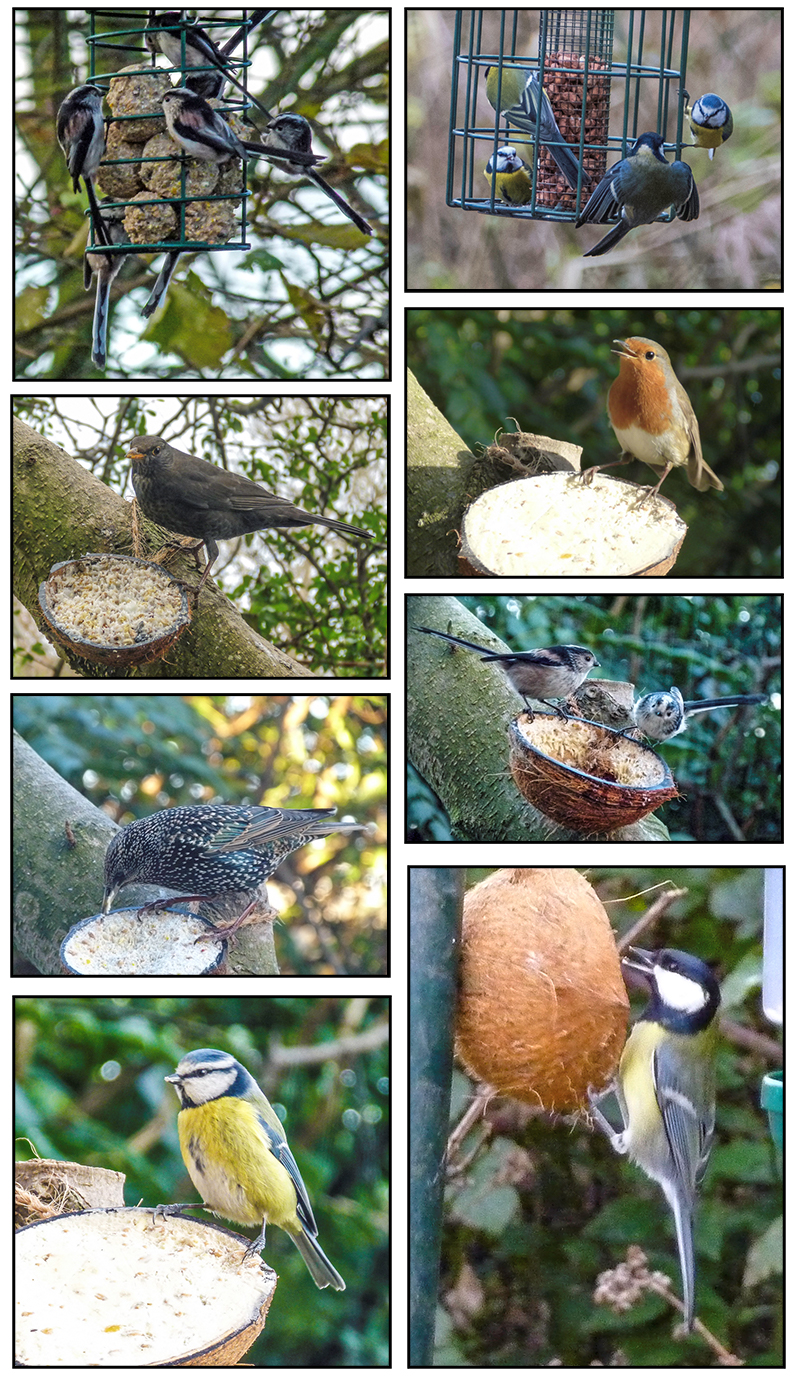
You can buy coconut shells ready filled with fat and if these are placed in a suitable position they will be much appreciated by the birds that can’t clink on feeders but be warned they won’t last very long.
Sometimes we used the empty shells as containers in which to place other food such as the female blackbird on the left. Mealworm can also be served in the type of wire baskets often used for peanuts.
Although it is specially important to help the birds during winter by putting out food birds can also suffer from food shortages during summer and spring.
We have found that unlike as is commonly believed adults birds will not feed their babies unsuitable food but they will visit feeders to feed themselves.
Once the young have fledged the adults will lead them to the feeding stations in the garden.
So we feed the birds all year round.

Click here for information about what to feed birds at different times of the year.
s well as providing food for birds it is important that birds have access to areas where they can forage for natural food. Lawned areas are ideal as is shown by this blackbird. I watched her wiping the slug she has in her beak in the grass to remove some of the slime.
Piles of dry leaves also provide foraging for the birds during winter as do areas under shrubs that may stay clear of frost and snow during very cold weather.
Piles of broken snail shells may indicate that song thrushes or blackbirds have been feasting.
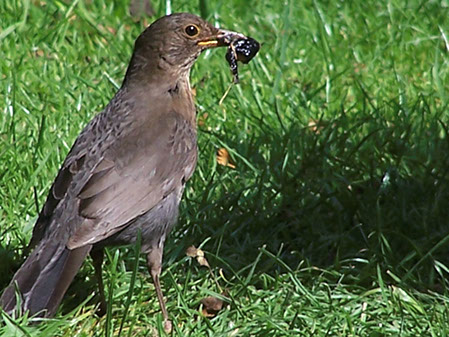
Many birds consume a huge number of caterpillars during the nesting season. Even seed eating birds feed nestlings on insects and spiders so that the young develop strong feathers.
As well as needing food birds need access to fresh water at any time during the year. The fieldfare and redwing photographed here arrived in our garden during especially cold winter weather in 2010 to take advantage of the area on our pond that wasn’t frozen.
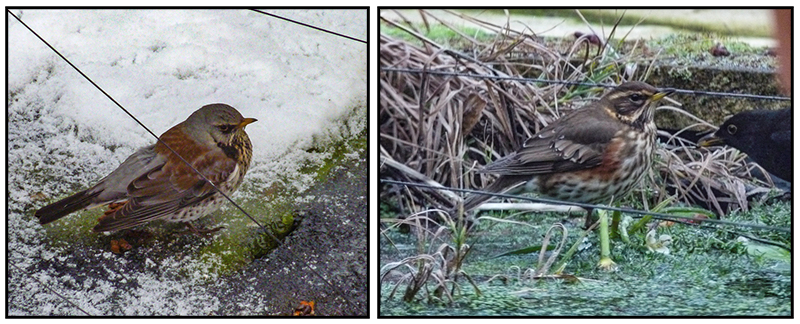
During icy weather we try to keep some water in our bird baths ice free as not only do the birds need to drink but will also bathe in icy weather so that their feathers stay in good condition and insulate them against the biting cold.

Equally it is important to keep water supplies topped up during summer when it can be difficult for the birds to find water.
It’s inevitable that where there are lots of small birds that the larger birds of prey will arrive looking for a meal. There is more about the sparrowhawks that have visited us here.
Our garden pond has also attracted herons which I’m afraid we can’t welcome. We haven’t managed to take any photos of herons as when they arrive we are too busy sending them on their way. I’m afraid the line is drawn at sacrificing our fish.
Where lots of birds gather to feed and bathe etc there is a risk of disease spreading so if you feed birds it is important to read this article on the RSPB web site.
Our Plot at Green Lane Allotments Blog | A Gardener's Weather Diary | School Vegetable Patch Website
© Our Plot on Green Lane Allotments - Please email me if you wish to use any of this site's content